Topics
Category
Era
Treaty of Traverse des Sioux, 1851
Painting by Frank B. Mayer, a witness to the negotiations and signing of the Treaty of Traverse des Sioux. Painted in 1885.
The Treaty of Traverse des Sioux (1851) between the Sisseton and Wahpeton bands of Dakota and the US government transferred ownership of much of southeastern Minnesota Territory to the United States. Along with the Treaty of Mendota, signed that same year, it opened twenty-four million acres of land to settler-colonists. For the Dakota, these treaties marked another step in a process that increasingly marginalized them and dismissed them from the land that had been—and remains—their home.
During the early decades of the 1800s, white immigrants began moving west of the St. Croix River into the territory of the Dakota and the Ojibwe. Though the newcomers' numbers were relatively small at first, they were eager to use the land for farming and industry. They wanted to move further west, deeper into Native homelands. Influential men, including Alexander Ramsey and Henry Sibley, convinced the US government to negotiate the purchase of land from Native people. Through this transaction, Ramsey and Sibley also hoped to recoup debts that fur traders claimed various bands owed to them.
By 1850, both the Sisseton and Wahpeton bands of Dakota were in a dire situation. Overhunting had depleted the animals—particularly bison—that they relied on for food and trade. Some groups saw selling their land as a way to gain resources they needed to survive. A land cession treaty, with guaranteed annuity payments, could help them through these tough times and, for some Dakota, offered a way to rebuild their communities.
In July 1851, Sibley, Ramsey, and federal commissioner Luke Lea chose Traverse des Sioux as the site for treaty negotiations. It took several weeks for enough representatives of the Sisseton and Wahpeton bands to arrive. Once they had arrived, however, it did not take long to come to an agreement. The Dakota were in a very weak bargaining position because they believed that if they did not sell their land, the United States would take it. Negotiations took several days, and some Dakota leaders initially resisted the demands made by the commissioners because they asked for so much. Ultimately, however, the Dakota agreed to the treaty.
On July 23, the Dakota signed the treaty with the government commissioners. It had three primary results. First, it ceded much of the southern and western portion of Minnesota to the US for about seven and a half cents an acre. Second, Dakota people retained a reservation of land ten miles wide on each side of the Minnesota River. Finally, the treaty arranged for payment to the Sisseton and Wahpeton bands for the land they had ceded. They were to receive a portion of the money immediately. Some funds were set aside for the construction of schools and other services. The rest was to be placed in an account managed by the federal government. From that account, the bands were to receive an annual interest payment in both cash and goods.
After the Dakota leaders had signed two copies of the treaty, they were directed to a third piece of paper held by Joseph R. Brown, a prominent fur trader. All but two of them also signed this agreement. The document, known as the traders' paper, directed the government to pay off various debts claimed by white and métis fur traders using the money owed to the bands from the treaty. This repayment method was common at the time, and the Dakota, given the chance, would perhaps have agreed to it. However, the deceptive methods that Brown and other traders used to get the leaders to sign angered the Dakota. No one read the paper aloud or translated it for the Dakota, many of whom believed it to be another copy of the treaty. Deception was not an uncommon tactic for government officials during treaty signings, so the traders’ paper gave Dakota people, already distrustful of the federal government, yet another reason to be wary of future negotiations.
Following the treaty, Sibley, Ramsey, and Lea negotiated a similar treaty at Mendota with other Dakota bands, which was signed on August 5. In the decade after the signing of these treaties, over 100,000 white immigrants moved to Minnesota to live on the land that Indigenous peoples had ceded.
Bibliography
“1851 Dakota Land Cession Treaties.” Relations: Dakota & Ojibwe Treaties. Why Treaties Matter.
http://treatiesmatter.org/treaties/land/1851-Dakota
Atkins, Annette. Creating Minnesota: A History from the Inside Out. St. Paul: Minnesota Historical Society Press, 2007.
Folwell, William Watts. A History of Minnesota. Vol. 1. St. Paul: Minnesota Historical Society Press, 1956.
Gilman, Rhoda R. "Territorial Imperative: How Minnesota Became the 32nd State." Minnesota History 56, no. 4. (Winter 1998): 154–171.
http://collections.mnhs.org/mnhistorymagazine/articles/56/v56i04p154-171.pdf
——— . Henry Hastings Sibley: Divided Heart. St. Paul: Minnesota Historical Society Press, 2004.
Lass, William E. The Treaty of Traverse des Sioux. St. Peter: Nicollet County Historical Society Press, 2011.
“The Sioux Treaty.” Minnesota Pioneer, July 3, 1851.
“The Sioux Treaty.” Minnesota Pioneer, August 7, 1851.
“The Sioux Treaty.” Minnesota Pioneer, August 14, 1851.
“The Treaty.” Minnesota Pioneer, July 24, 1851.
“The Treaty with the Sioux.” Minnesota Pioneer, July 31, 1851.
Treaty with the Sioux—Sisseton and Wahpeton Bands, 1851.
https://dc.library.okstate.edu/digital/collection/kapplers/id/29608/rec/1
Westerman, Gwen, and Bruce White. Mni Sota Makoce: The Land of the Dakota. St. Paul: Minnesota Historical Society, 2012.
Wingerd, Mary Lethert. North Country: The Making of Minnesota. Minneapolis: The University of Minnesota Press, 2010.
Related Resources
Primary
“Editorial Correspondence.” Minnesota Pioneer, July 10, 1851.
“Editorial Correspondence.” Minnesota Pioneer, July 17, 1851.
Le Duc, William G., A Brief Sketch and History of the Signing of the Treaty of Traverse des Sioux. St. Peter: Daughters of the American Revolution, 1947.
Description: This pamphlet includes the first-person account of William G. Le Duc, a newspaper reporter who was present at the treaty negotiations.
P2285
Philander Prescott Reminiscences and Related Papers
Manuscripts Collection, Minnesota Historical Society, St. Paul
http://www2.mnhs.org/library/findaids/P2285.xml
Description: Prescott was an interpreter during negotiations of the Treaty of Traverse des Sioux.
115.I.19.10F
Protests of Dakota Chiefs and Accompanying Certifications
Minnesota Territorial Secretary Records
Manuscripts Collection, Minnesota Historical Society, St. Paul
Description: The territorial government’s official copy of the protest over the Traders’ Paper.
A/-E95
William G. Ewing and George W. Ewing papers, 1847–1882
Manuscripts Collection, Minnesota Historical Society, St. Paul
Description: This collection contains typewritten copies of letters regarding payments to fur traders after the Treaty of Traverse des Sioux.
P643
Frank B. Mayer papers, 1851–1903
Manuscripts Collection, Minnesota Historical Society, St. Paul
Description: This collection contains copies from a diary kept by Mayer during his travels around the time of the Treaty. An artist, Mayer produced paintings of the treaty signing, which he witnessed.
M45
Materials Relating to the 1851 Dakota Treaties, 1849–1952
Manuscripts Collection Microfilm, Minnesota Historical Society, St. Paul
Description: A microfilm copy of materials held by the National Archive, it includes copies of the treaty, the treaty commission’s journal, correspondence between treaty commissioners and the federal government, as well as a report by the commissioners.
M24
Hercules L. Dousman Papers, 1848–1853
Manuscripts Collection Microfilm, Minnesota Historical Society, St. Paul
Description: This collection mostly holds the correspondence of Dousman, a Wisconsin fur trader and land speculator. Some letters concern the treaty negotiations.
Secondary
Keillor, Steven J. Shaping Minnesota’s Identity: 150 Years of State History. Lakeville: Pogo Press, 2008.
Lass, William E. Minnesota: A Bicentennial History. New York: Norton, 1977.
Web
AV2011.45.18
US–Dakota War of 1862 Oral History Project: Interview with Walter LaBatte, April 28, 2011
Oral History Collection, Minnesota Historical Society, St. Paul
http://collections.mnhs.org/cms/display.php?irn=11007770
Description: Walter "Super" LaBatte, a member of the Sisseton-Wahpeton Lake Traverse Reservation reflects on the history of the Dakota People. Among the topics discussed are the Treaties of 1851.
AV2011.45.18
US–Dakota War of 1862 Oral History Project: Interview with Willard Manderfeld, August 11, 2011
Oral History Collection, Minnesota Historical Society, St. Paul
http://collections.mnhs.org/cms/display.php?irn=11008045
Description: Willard Manderfeld, a resident of New Ulm, discusses his ancestors involvement in the US–Dakota War of 1862. He reflects upon the Treaties of 1851.
Minnesota Historical Society. Traverse des Sioux.
https://www.mnhs.org/traversedessioux
Related Images
Detail of a map of the "Hydrographical basin of the upper Mississippi River from astronomical and barometrical observations, surveys, and information," created in 1843 by Joseph N. Nicollet for the US War Department. The drafters of the Treaty of Traverse des Sioux (1851) used the map to delineate land cessions, and to claim land from the Sisseton Dakota around Pipestone Quarry that was actually the territory of the Yankton Dakota. The Yankton did not cede said territory until the ratification of an 1858 treaty signed in Washington, DC.
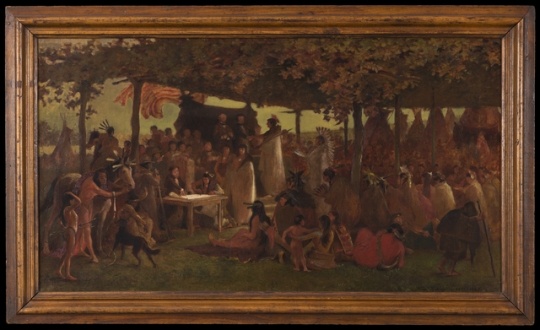
Treaty of Traverse des Sioux
Painting by Frank B. Mayer, a witness to the negotiations and signing of the Treaty of Traverse des Sioux. Painted in 1885.
Public domain
Holding Location
More Information
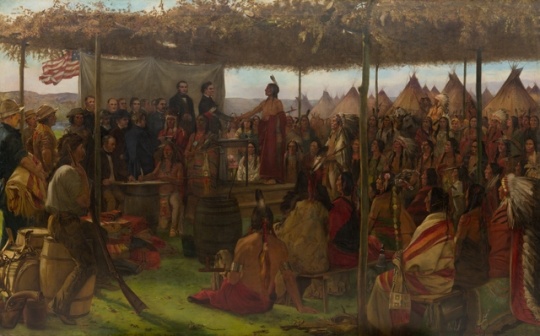
Painting of the Treaty of Traverse des Sioux
Painting of the Treaty of Traverse des Sioux, c.1905. Oil painting by Francis Davis Millet.
Holding Location
More Information
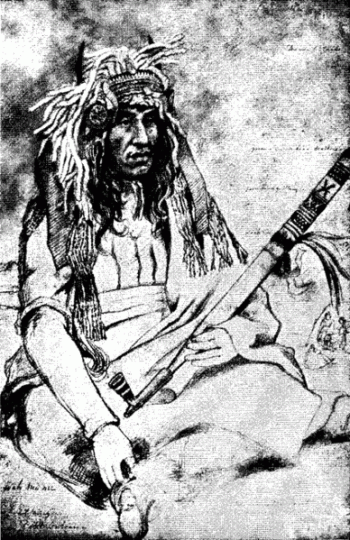
Taoyateduta (Little Crow IV)
Dakota Leader Taoyateduta (Little Crow IV) sketched at Traverse des Sioux, Minnesota Territory, in 1851 by artist Frank Blackwell Mayer.
Public domain
More Information
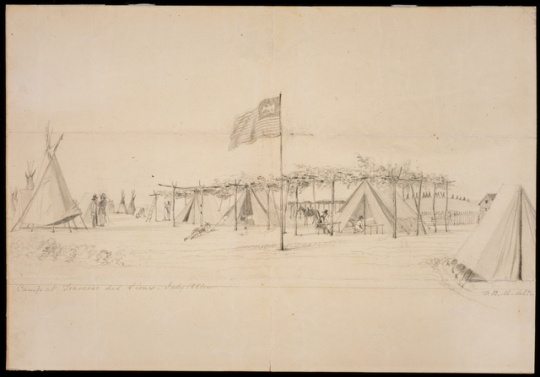
Camp at Traverse des Sioux
A drawing of the camp at the treaty negotiation site by Frank B. Mayer, 1851.
Public domain
Holding Location
Articles
More Information
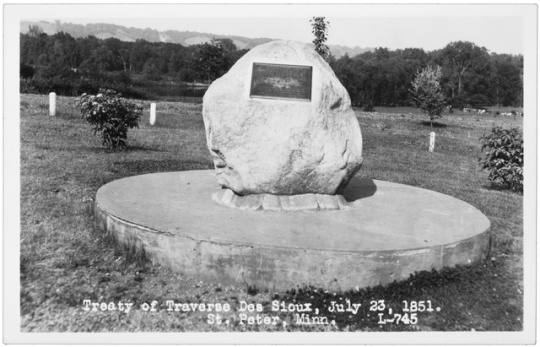
Traverse des Sioux treaty marker.
A stone marking the site of the treaty, c.1950.
Holding Location
Articles
More Information
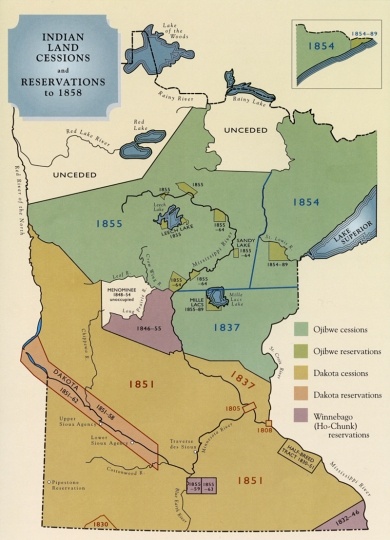
Native American Land Cessions and Reservations to 1858
Map of the lands within Minnesota Territory ceded by Native Americans by 1858. Created by Alan Ominsky ca. 1999. Reproduced in Making Minnesota Territory, 1849–1858 (St. Paul: Minnesota Historical Society Press, 1999), page 7.
Holding Location
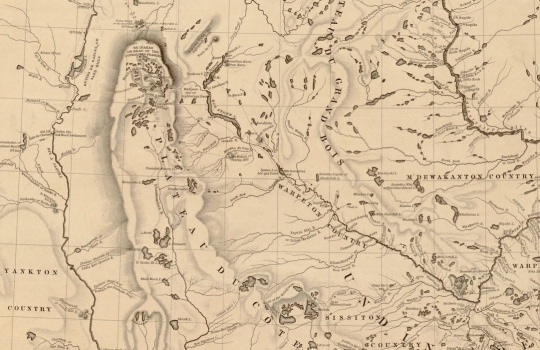
Map of the Upper Mississippi River basin, 1843
Detail of a map of the "Hydrographical basin of the upper Mississippi River from astronomical and barometrical observations, surveys, and information," created in 1843 by Joseph N. Nicollet for the US War Department. The drafters of the Treaty of Traverse des Sioux (1851) used the map to delineate land cessions, and to claim land from the Sisseton Dakota around Pipestone Quarry that was actually the territory of the Yankton Dakota. The Yankton did not cede said territory until the ratification of an 1858 treaty signed in Washington, DC.
Holding Location
Articles
More Information
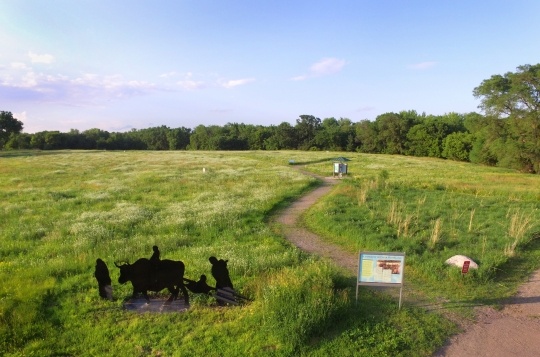
Traverse des Sioux
Prairie land at Traverse des Sioux, the site of the signing of the 1851 Treaty of Traverse des Sioux, ca. 2010s. Photograph by John Cross courtesy of Minnesota Historical Society.
All rights reserved
Articles
More Information
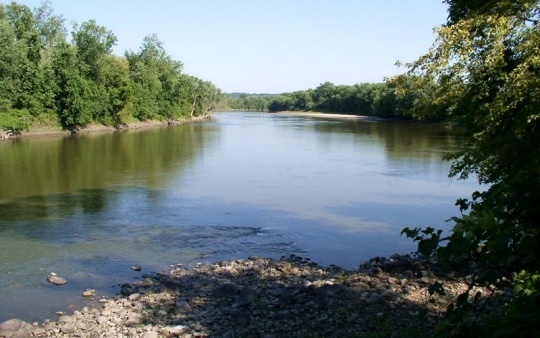
Traverse des Sioux
The Mni Sota Wakpa (Minnesota River) at Traverse des Sioux, September 3, 2007. Photograph by Wikimedia Commons user McGhiever. GNU Free Documentation License 1.2
Holding Location
Articles
More Information
Related Articles
Turning Point
On July 23, 1851, the Treaty of Traverse des Sioux cedes several million acres of land from the Sisseton and Wahpeton bands of Dakota to the United States in exchange for a reservation and annual annuity payments.
Chronology
1805
1819
1825
1837
1851
1852
1857
1863
1867
Bibliography
“1851 Dakota Land Cession Treaties.” Relations: Dakota & Ojibwe Treaties. Why Treaties Matter.
http://treatiesmatter.org/treaties/land/1851-Dakota
Atkins, Annette. Creating Minnesota: A History from the Inside Out. St. Paul: Minnesota Historical Society Press, 2007.
Folwell, William Watts. A History of Minnesota. Vol. 1. St. Paul: Minnesota Historical Society Press, 1956.
Gilman, Rhoda R. "Territorial Imperative: How Minnesota Became the 32nd State." Minnesota History 56, no. 4. (Winter 1998): 154–171.
http://collections.mnhs.org/mnhistorymagazine/articles/56/v56i04p154-171.pdf
——— . Henry Hastings Sibley: Divided Heart. St. Paul: Minnesota Historical Society Press, 2004.
Lass, William E. The Treaty of Traverse des Sioux. St. Peter: Nicollet County Historical Society Press, 2011.
“The Sioux Treaty.” Minnesota Pioneer, July 3, 1851.
“The Sioux Treaty.” Minnesota Pioneer, August 7, 1851.
“The Sioux Treaty.” Minnesota Pioneer, August 14, 1851.
“The Treaty.” Minnesota Pioneer, July 24, 1851.
“The Treaty with the Sioux.” Minnesota Pioneer, July 31, 1851.
Treaty with the Sioux—Sisseton and Wahpeton Bands, 1851.
https://dc.library.okstate.edu/digital/collection/kapplers/id/29608/rec/1
Westerman, Gwen, and Bruce White. Mni Sota Makoce: The Land of the Dakota. St. Paul: Minnesota Historical Society, 2012.
Wingerd, Mary Lethert. North Country: The Making of Minnesota. Minneapolis: The University of Minnesota Press, 2010.
Related Resources
Primary
“Editorial Correspondence.” Minnesota Pioneer, July 10, 1851.
“Editorial Correspondence.” Minnesota Pioneer, July 17, 1851.
Le Duc, William G., A Brief Sketch and History of the Signing of the Treaty of Traverse des Sioux. St. Peter: Daughters of the American Revolution, 1947.
Description: This pamphlet includes the first-person account of William G. Le Duc, a newspaper reporter who was present at the treaty negotiations.
P2285
Philander Prescott Reminiscences and Related Papers
Manuscripts Collection, Minnesota Historical Society, St. Paul
http://www2.mnhs.org/library/findaids/P2285.xml
Description: Prescott was an interpreter during negotiations of the Treaty of Traverse des Sioux.
115.I.19.10F
Protests of Dakota Chiefs and Accompanying Certifications
Minnesota Territorial Secretary Records
Manuscripts Collection, Minnesota Historical Society, St. Paul
Description: The territorial government’s official copy of the protest over the Traders’ Paper.
A/-E95
William G. Ewing and George W. Ewing papers, 1847–1882
Manuscripts Collection, Minnesota Historical Society, St. Paul
Description: This collection contains typewritten copies of letters regarding payments to fur traders after the Treaty of Traverse des Sioux.
P643
Frank B. Mayer papers, 1851–1903
Manuscripts Collection, Minnesota Historical Society, St. Paul
Description: This collection contains copies from a diary kept by Mayer during his travels around the time of the Treaty. An artist, Mayer produced paintings of the treaty signing, which he witnessed.
M45
Materials Relating to the 1851 Dakota Treaties, 1849–1952
Manuscripts Collection Microfilm, Minnesota Historical Society, St. Paul
Description: A microfilm copy of materials held by the National Archive, it includes copies of the treaty, the treaty commission’s journal, correspondence between treaty commissioners and the federal government, as well as a report by the commissioners.
M24
Hercules L. Dousman Papers, 1848–1853
Manuscripts Collection Microfilm, Minnesota Historical Society, St. Paul
Description: This collection mostly holds the correspondence of Dousman, a Wisconsin fur trader and land speculator. Some letters concern the treaty negotiations.
Secondary
Keillor, Steven J. Shaping Minnesota’s Identity: 150 Years of State History. Lakeville: Pogo Press, 2008.
Lass, William E. Minnesota: A Bicentennial History. New York: Norton, 1977.
Web
AV2011.45.18
US–Dakota War of 1862 Oral History Project: Interview with Walter LaBatte, April 28, 2011
Oral History Collection, Minnesota Historical Society, St. Paul
http://collections.mnhs.org/cms/display.php?irn=11007770
Description: Walter "Super" LaBatte, a member of the Sisseton-Wahpeton Lake Traverse Reservation reflects on the history of the Dakota People. Among the topics discussed are the Treaties of 1851.
AV2011.45.18
US–Dakota War of 1862 Oral History Project: Interview with Willard Manderfeld, August 11, 2011
Oral History Collection, Minnesota Historical Society, St. Paul
http://collections.mnhs.org/cms/display.php?irn=11008045
Description: Willard Manderfeld, a resident of New Ulm, discusses his ancestors involvement in the US–Dakota War of 1862. He reflects upon the Treaties of 1851.
Minnesota Historical Society. Traverse des Sioux.
https://www.mnhs.org/traversedessioux










